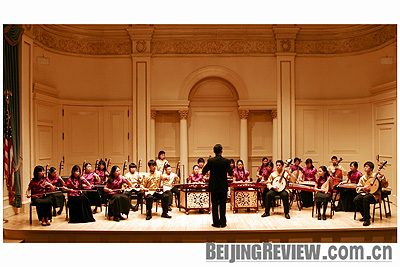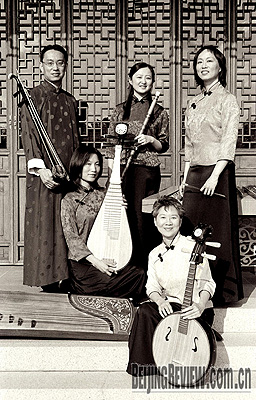|

CROSSOVER : The Music From China Youth Orchestra performs its debut concert at New York's Carnegie Hall on March 1
The ethereal, haunting sounds of Chinese traditional music can instantly transport a person to placid mountain lakes or back in time to the country's rich historical past. The melodic compositions are recognized as an integral part of Chinese history and culture, yet, as purely "Chinese" the instruments may be, their roots are multicultural. Traders along the ancient Silk Road brought music in addition to their wares and so the foreign sounds of instruments like the Arabian lute transformed into the Chinese pipa.
New York-based Music From China (MFC), a chamber ensemble that has a passion for educational outreach, represents the modern evolution of Chinese traditional music. And like the Silk Road composers in times past, the group combines the most iconic traditional Chinese instruments--such as the erhu, pipa, zheng and dizi--with Western instruments in breathtaking modern compositions that take the best of both worlds and create an entirely new sound.
"We wanted to play traditional music and develop it in contemporary ways," says Executive Director Susan Cheng.
The group was founded in 1984, and to celebrate its 25th anniversary next year MFC has commissioned two new compositions. One is a blending of traditional Chinese music with a saxophone quartet called PRISM Quartet, a group chosen by Musical America as "Outstanding Young Artists" and winners of the Chamber Music America/ASCAP Award for Adventurous Programming and the Fischoff National Chamber Music Competition, among other accolades. The new pieces will be recorded on a CD, and the two groups will go on tour across the country.
"[Prism] said it was the first time they had ever heard of this type of combination of saxophones with traditional Chinese instruments," Cheng told Beijing Review.
But do all Western instruments mix harmoniously with the sounds of the Chinese erhu or pipa?
"It's in the way it is written," says Artistic Director Wang Guowei, with Cheng translating. "Anything can be combined with the right composer and most composers are open to new instruments."

STAYING IN TUNE: Music From China, founded in 1984, is a chamber ensemble that performs traditional and contemporary Chinese music with classical instruments
Wang is composing another piece to be performed in 2009. The blended works have found fans across the world.
"People love it. It's more accessible," Cheng said. "Instead of just strange sounds there is a point of reference, and it's easier to understand."
The group also performs traditional works of Chinese music, and one of its missions is to preserve the musical heritage of China with performances, classes and workshops. The group holds music programs in New York and New Jersey during the low season of its performance schedule. While classes are dominated by Chinese-American families seeking to connect with their heritage, students from multicultural families also attend the classes. The classes are popular, and what started out as summer camp programming has been extended throughout the year. In addition to musical training, the classes also teach participants about Chinese culture and traditions.
In 2006, MFC launched the China Youth Orchestra. Members range in age from seven to 18 years old, Cheng said. The group of 25 members performed recently at Carnegie Hall in its debut concert "Music Rainbow." The performance included Chinese and American music on the erhu, yangqin, liuqin, ruan, zheng, hulusi, cello and percussion instruments.
This July 15 members of the Youth Orchestra will travel to Shanghai for five days to perform with the Shanghai Municipal Children's Palace Orchestra. In addition to rehearsals and performances, the students will also tour musical sights in the city and have a cultural exchange with the Shanghai orchestra members. The Shanghai orchestra members bring with them their dedication, discipline and well-trained talent, while the American students will share their creativity and passion. Playing songs by American composers such as George Gershwin is a great thing for the Shanghai students as well, she adds, as it teaches them musical stylings that they may not have learned before.
"America is a crossroads," Cheng says, "we like to mix things up and see what comes out of it."
And in the Internet era, dragging kids away from the computer and into a group, cultural activity is good for their development. The compositions that MFC creates are musically exciting, with an emphasis on exploration.
"Some things work and some things don't work," Cheng says. "Traditional music is always the same. It doesn't have the same challenge."
Over the past 25 years, MFC has performed 111 new works by 67 composers. Half of those were commissioned pieces by well-known composers, and the other half were from unknown, emerging composers who were winners in MFC's annual International Composition Competition. The competition, which has been held since 1992, encourages emerging Chinese composers to write pieces for traditional instruments. Since the prize money for the winners is relatively small, the contest tends to attract young composers at the college, and even high school, level in China. These emerging artists then get a chance to have their composition performed by MFC in their annual performance.
"Every year the contestants get younger and more talented," Cheng says. "As China grows richer, there is more opportunity for composers to get funding, so ours is a little award aimed at the young."
Music From China's work has earned them numerous awards and accolades. It was the first Chinese ensemble to receive an Adventurous Programming award from Chamber Music America and the American Society of Composers, Authors and Publishers (ASCAP) for its creative programs. The group has collaborated with famous groups such as Four Nations Ensemble, Ethos Percussion Group and Present Music and with artists such as Yo-Yo Ma, Fred Sherry, Alan Kay and Rao Lan.
As a small ensemble, Music From China is on a constant search for funding to enable it to carry out its educational programs and to commission new works of blended East/West compositions. The group has seven core musicians as members, and then hires Western Instrumental performers as needed. In addition to local funders such as the New York Foundation for the Arts and New York State Music Fund, the group is also supported by the National Endowment for the Arts, Aaron Copland Fund for Music, Chamber Music America and other notable organizations. CDs of the group's music and performance schedule are available at www.musicfromchina.org.
(Reporting from New York)
Traditional Chinese Instruments
Guzheng
The guzheng is built with a special wooden sound body with strings arched across movable bridges along the length of the instrument for the purpose of tuning. The guzheng nowadays has 12 or 13 strings. The pitch of a given string is determined by the position of the bridge.
Dizi
The dizi is a flute known for its bamboo body, edged tone and side-holes. The modern flute has an octave range of about two and a half. It can have a membrane over an extra hole to give the characteristic rattle effect. The dizi is played by blowing across the mouthpiece and produces different notes by stopping the six holes found in the rod. |